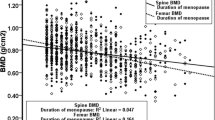Abstract:
The present study analyzed the factors that determine bone mineral density (BMD) and predict spinal fracture risk in postmenopausal Japanese women. Two hundred and five postmenopausal Japanese women aged 48–84 years (mean age 64 years) were enrolled in the cross-sectional study. BMD of the lumbar spine, femoral neck and total body as well as body composition were measured by dual-energy X-ray absorptiometry (DXA). Mid-radial BMD was measured by single-photon absorptiometry. We also determined serum levels of insulin-like growth factor (IGF)-I, IGF binding protein-2, -3 and osteocalcin as well as urinary levels of pyridinoline (Pyr), deoxy-Pyr (D-Pyr) and growth hormone. Multiple regression analysis revealed that lean body mass (LBM) was positively correlated with BMD at all sites. In contrast, femoral neck BMD was highly related to fat mass as well as LBM, although fat mass was not an independent correlate of total body and mid-radial BMD. LBM and urinary D-Pyr were crucial determinants at all sites except the mid-radius in stepwise regression analysis. Fat mass and serum IGF-I were determinants of femoral neck and mid-radial BMD, respectively. In terms of reproductive history, parity affected lumbar BMD. Factors affecting BMD differed according to the site. On the other hand, lumbar BMD as well as serum levels of IGF-I and albumin were selected as predictors of spinal fracture risk in multiple logistic regression analysis. Lumbar BMD, serum IGF-I and LBM were selected in women with lumbar BMD above 0.727 g/cm2. In conclusion, the present study indicates that LBM is a more important determinant of BMD than fat mass at any site except the femoral neck. Age, serum IGF-I and urinary D-Pyr were also determinants of BMD, dependent on the regions measured. Lumbar BMD and LBM as well as serum levels of IGF-I and albumin were useful markers which predicted the risk of osteoporotic spinal fractures in postmenopausal Japanese women.
Similar content being viewed by others
Author information
Authors and Affiliations
Additional information
Received: 6 June 2000 / Accepted: 11 January 2001
Rights and permissions
About this article
Cite this article
Nakaoka, D., Sugimoto, T., Kaji, H. et al. Determinants of Bone Mineral Density and Spinal Fracture Risk in Postmenopausal Japanese Women . Osteoporos Int 12, 548–554 (2001). https://doi.org/10.1007/s001980170075
Issue Date:
DOI: https://doi.org/10.1007/s001980170075



